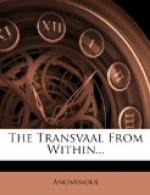In Bechuanaland they took sides; that is to say, parties of freebooters from the Transvaal took up the cause of certain native chiefs against certain others. The London Convention in 1884 disposed of this quarrel by fixing the south-western boundaries of the Republic, and placing two of the disputing chiefs under the Transvaal, and the other two under British protection. Notwithstanding this, however, the new Convention was no sooner signed than the scheming was resumed, and before a year had passed a party of Transvaal Boers, several of them now holding high official positions under the Republic, raided the territory of the chiefs in the British Protectorate, and even attacked the chief town Mafeking. This was followed by a proclamation by President Kruger placing the territory under the protection of the Republic. Mr. Rhodes, who had already made himself conspicuous by his advocacy of holding the highway to the interior open, was instrumental in inducing the Imperial Government to make a determined stand against this. An ultimatum moved the Transvaal Government to withdraw the proclamation and forced the Boers to leave the country—only, however, when and because the demand was backed by the Warren expedition at a cost of over a million and a half to the British taxpayer! This expedition was sent by Mr. Gladstone, the Boer benefactor—notwithstanding all his anxiety to prove the Transvaal settlement a good one! The action of the Transvaal, and the most brutal murder of Mr. Bethell by the individuals above referred to as holding high official positions under the Republic, gave indications of the bent of the Boer authorities which people in South Africa did not fail to take note of. Bethell had been wounded in the invasion of the territory by the Boers, and as he lay helpless the ‘prominent Transvaal official’ came up and, seeing a repeating rifle lying beside him, asked him to show them how it worked. He did so, and the ‘prominent official’ taking it up under pretext of examining it shot Bethell dead with his own weapon.
In Zululand similar tactics were resorted to by the Republic. Transvaal Boers invaded Zululand and (1884) took up the cause of Dinizulu, a son of the dead Cetewayo, and established him as king, upsetting Sir Garnet Wolseley’s settlement. They then proceeded to seize the country, but the British Government intervening at this point, rescued some two-thirds for the Zulus. A glance at the map will show that the intention of the Boers was to get to the sea, and also that the unlucky Zulus, who had been broken by the British Government—and very rightly too—because they were a menace to the Transvaal, even more than to Natal, were now deprived of the pick of their country, plundered and harried by the very people who had been at their mercy until the Imperial Government stepped in. It is very noteworthy that, with the splendid exception of the lion-hearted Piet Uys and his sons, who fought and died (father and one son) in the Zulu war side by side with the Britishers whom he was keenly opposing on the annexation question, none of the Boers came forward to help in the Secocoeni or Zulu wars, although these wars were undertaken, the one entirely, and the other mainly, on their account. But a great many were ready to raid and annex as soon as the Zulu power was broken.




